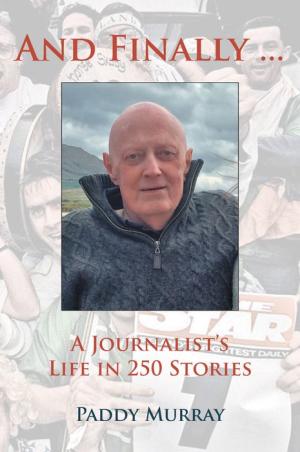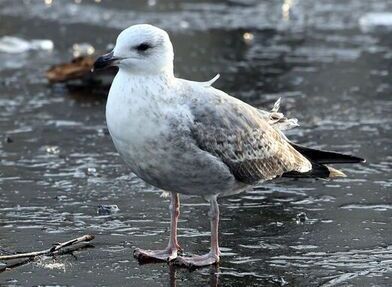Columbo always had just one more question. Paddy Murray always had one more story.
But he drew the line at 250 of them and he placed them in a book which comes with the title “And Finally…”
But of course the book itself is a story in and of itself.
And it explains much.
By this I mean that it delivers a wonderful insight into the Ireland of the recent past and the practice of Irish journalism that, during the 1980s in particular, went through a metamorphosis as technology and societal change pulled the country into line with the twentieth century, while propelling it into the 21st.
Paddy Murray rode the wave of all that propelling.
Here’s a sense of the man and the journalist from the publicity accompanying the book.
“By any account Paddy Murray has had a remarkable life. From meeting entertainment and sports celebrities like John Wayne, Pele, Madonna, Eric Clapton, Richard Harris, Elton John, George Harrison, Eric Cantona and Eddie Irvine, to reporting on Ireland's heroic loss in the World Cup at Italia '90, to writing about Irish political scandals, tragedies, heinous crimes and much more over 40 years in the Evening Herald, Irish Daily Star, Sunday World and The Sunday Tribune, Paddy has seen it all.
“Along the way, Paddy managed to write gags for the Two Ronnies, performed comedy in front of a live audience, erected a plaque commemorating The Beatles' only Irish performance at the Adelphi Cinema in Dublin, battled with Lymphoma for over 20 years and became a father at 50+.
“Looking back on a colourful life while now struggling with more health challenges - Stage 4 COPD - Paddy is adamant that the highs far outweigh the lows, that his marriage to Connie and the love of his daughter Charlotte make every painful treatment worthwhile. So come along on an entertaining journey recalling one journalist's extraordinary life in 250 stories!”
I took the journey, starting with story number one and all that followed from Paddy's pen as he reported for, and edited, a range of Irish publications including the Evening Herald, Sunday World and Sunday Tribune, of which he was editor between 2003 and 2005.
According to his wikipedia entry, Murray wrote a regular column in the Dublin paper, the Sunday World until May 2019 when he was told that, due to cutbacks, his column was being dropped, ending 46 years of writing for newspapers in the Independent Group. The last column appeared on 5 May 2019.
Well, no better moment to start writing about all that writing. And so the book.
From the moment I cracked the cover I was in a familiar place. This was Paddy's working life, and it was, in significant part, my working life.
Our respective life in newspapers have been exercises in parallels and crossover, though in Paddy's case the start was a good deal less planned. I actually had a mind to try my hand in journalism before leaving secondary school. Paddy had other things on his mind in that same school, albeit in a class a couple of years ahead of me.
His arrival in the world of Dublin and Irish journalism was as a result of one of Irish journalism's most redeeming factors, at least back in the 1970s and '80s. You could still get in the door with a little luck and pluck. It wasn't like the practice of law or example, entry for it being all to do with formal academic qualifications.
So you could be dreaming of a newsroom post on Monday and be in it by Friday all the while wondering what the hell happened Tuesday, Wednesday and Thursday.
There were quite a few accidental journalists about in the 1970s and '80s, and Irish society benefited greatly as a result.
Paddy's book is a journey through the last three decades of Ireland's twentieth century. Like his colleagues, he was an eyewitness to triumph and disaster, change and stubborn retrenchment.
There would be moments when you would pinch yourself and wonder what in the name of God was going on - or not going on. There were moments when your capacity for astonishment was stretched to the limit, or stretched beyond it.
It was a wild ride. I know because I was along with Paddy and others for much of the 1980s version of it.
The 1980s will forever be a standout in Ireland's modern history. The decade was in significant part an economic damp squib, but at the same time attitudes and expectations, particularly among Ireland's young, were changing in many and profound ways.
I took leave of Ireland in 1987 and crossed the Atlantic for the second part of my life in newspapers.
Paddy remained in Ireland, and in working terms lived what might have been my Irish life had I stayed.
Prior to my departure our work proceeded in tandem and often crossed paths. Some of the biggest stories that Paddy covered between 1980 and '87 I also covered, though of course along with colleagues.
Paddy was with the Independent group, I was with the Irish Press group. We were rivals before deadline and fellow journos after it.
It was an era of political change, in Ireland's south and north. It was the time of GUBU, an acronym for "grotesque, unprecedented, bizarre, unbelievable," coined by Taoiseach Charles Haughey to describe the arrest of a murderer in the house of Ireland's attorney general, Patrick Connolly, in 1982.
And, yes, it was the time of Charlie and Garret and general elections seemingly every five minutes, of the Stardust disaster, the Anglo Irish Agreement, the loyalist Clontibret raid and the arrest at that County Monaghan crossroads of Peter Robinson.
Paddy covered all this, as did I.
Those years are worth a book in and of themselves. I might have considered writing it myself. But Paddy has scooped me.
In doing so he has not just presented readers with a personal memoir, but a vital archive, a picture and taste of a time still within living memory, but of course fading that little bit more with each passing day.
It was a time of manual typewriters and carbon copies, hot metal and newsrooms shrouded in cigarette smoke. It was a time of, yes, a lot of drinking. The Indo gang had their pubs, the Irish Times crowd had their pubs, and the Irish Press people had their pubs. Sometimes we would play away games and imbibe on foreign territory. A newspaper man or woman heading for a gym was about as likely as temperance in a brewery.
So, sadly, there were the inevitable casualties.
The first story I ever wrote for the Irish Press, on an early November day in 1980, was to summarize a health report by the National Union of Journalists (it represented journalists in both Ireland and Britain). It stated bluntly that the average age of death for an NUJ member was 57. 57!
What had I got in to I wondered while looking around the newsroom, my place of employment for all of a couple of days. The place was thick with cigarette smoke, so that said much. I should have gone into banking or the law, I thought. It was a thought that lasted mere seconds.
So here we are, Paddy and me. Peas from pretty much the same pod. It's Paddy's birthday this week (August 5) and I am sending my best across the ocean miles.
Paddy still writes his own blog, and it can be tracked down at www.theworldaccordingtopaddy.net. He is a husband and a proud father. He has brilliantly covered the who, what, where, when, how and why.
I'm still writing, and editing. And reading too. It's not long since I finished "And Finally..." but that's not the end of it. I know that at some point I will go back and read it all over again, for the memories, the laughs, and the required reminders of what it takes to battle on in this crazy business.
Well written Paddy Murray, and thanks for writing it all, the 250 stories and all the rest of them.
"And Finally..." is published by The Liffey Press, www.theliffeypress.com, and is also available online from Amazon and Barnes & Noble.








